Blowing out eggs is often part of preparing for Easter. Decorating or painting empty egg shells can be the perfect decoration for Easter festivities.
Blowing out an egg is a surprisingly easy activity, so you can also involve your little ones. We tried the method I’m describing here a couple of years ago. It is so simple we got it right on the first try. So even if it sounds intimidating at first, don’t be afraid of blowing out eggs!
Tools You’ll Need
You don’t need any special tools to blow out an egg that wouldn’t be found in your household. Once you’ve learned how to do it, decorating them will be even more fun – the only limit is your imagination!
These are the tools you’ll need to blow the eggs:
- Fresh eggs – I suppose this one goes without saying.
- A needle.
- Small or medium size scissors – these are even optional, see the method below.
- A bowl which you can blow the eggs into.
How To Blow Out An Egg
- First, wash thoroughly and dry off the egg.
- Hold the egg in one of your hands, and the needle in the other. Carefully push the needle in the top and bottom center of the egg. This step requires a little bit of force, but not too much. If you’re having trouble pushing the needle through the shell, you might want to use a small nail or tap it gently with a hammer!
- Widen the hole at the bottom using the scissors or simply by moving the needle in a circular motion. This is where the inside of the egg will come out, check the picture to see roughly how large the hole should be. Make sure to poke a wider hole at the bottom than the top. You don’t need to widen the hole at the upper part of the egg.
- Take the needle and push it into the hole at the top of the egg a few times carefully but with a bit of force so it pokes through the membrane inside your egg; stir it around to break up the yolk.
- Hold the egg over the bowl with the bigger hole facing down. Blow through the upper hole (be careful not to blow too hard) to get all the yolk and white out. You might need to find the necessary force for this action; blowing too hard might break the shell but if you are too gentle the egg content simply won’t come out.
- Clean the shell by holding it carefully under running water. Let a couple of teaspoons of water go inside the shell through the larger hole. Rinse it and pour the water out so that you clean it even from the inside.


What To Do With The Unused Egg Yolks And Whites?
The inside of the blown out egg is just as good as if you were to crack the eggs, therefore it could be used for anything you’d use eggs for. But make sure to disinfect your tools before using them, e.g. in hot water and vinegar.
This way you can use the eggs to make scrambled eggs or other egg dishes or even pastry. In fact it’s a good ingredient for any dish that requires whole eggs.
Cats also enjoy egg yolks, so if you’re not planning to use it up, just give it to your furry friend – they’ll love it!
But if you can’t find any good use for the leftover yolks, just throw them away! After all, it’s a small cost of getting to enjoy the Easter preparation!
How To Blow Out An Egg
Equipment
- Needle
- Bowl
- Pair of scissors (small, optional)
Materials
- Egg
Instructions
- First, wash thoroughly and dry off the egg.
- Hold the egg in one of your hands, and the needle in the other. Carefully push the needle in the top and bottom center of the egg.
- Widen the hole at the bottom using the scissors or simply by moving the needle in a circular motion. This is where the inside of the egg will come out, check the picture to see roughly how large the hole should be. Make sure to poke a wider hole at the bottom than the top. You don't need to widen the hole at the upper part of the egg.

- Take the needle and push it into the hole at the top of the egg a few times carefully but with a bit of force so it pokes through the membrane inside your egg; stir it around to break up the yolk.

- Hold the egg over the bowl with the bigger hole facing down. Blow through the upper hole (be careful not to blow too hard) to get all the yolk and white out.
- Clean the shell by holding it carefully under running water.



